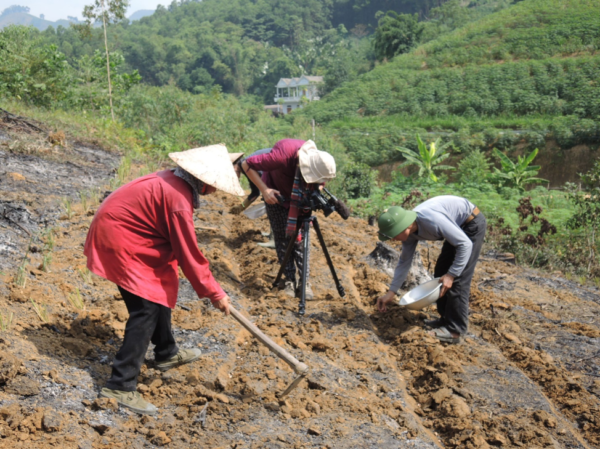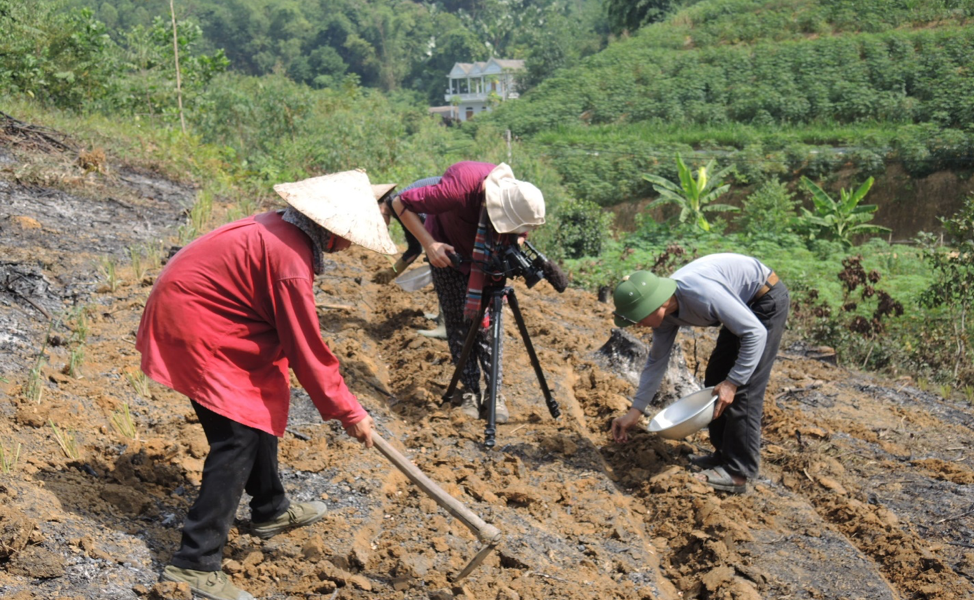As reported by Google, Southeast Asia has the fastest growing internet user base of any region on earth. With a monthly mobile internet connection often costing $US 2-3, an estimated 3.8 million new connections are added every month, and the region is expected to reach a staggering 480 million users by 2020. As internet continues to penetrate daily life and business, recent video extension work by the International Center for Tropical Agriculture (CIAT) under the rubric of the CGIAR Research Program on Roots, Tubers and Bananas (RTB) looked to harness this power to take aim at an RTB crop with high demand for extension information: cassava.

Farmers demonstrate the planting of a peanut intercrop during the filming of the ‘Growing cassava on sloping land’ educational video in Yen Bai, Northern Vietnam. Photo by Paul Van Mele.
In Southeast Asia the smartphone is king, accounting for over 90% of internet connections. For rural people, mobile devices are ideal links to the wider world: portable, inexpensive, easy to charge and maintain, and intuitive to use. Farmers are no exception, increasingly using smartphones to search for information about crops and their markets, to share experiences and observations, and to seek advice on management issues. Here CGIAR’s long history of production and use of audio-visual knowledge products for farmer extension is poised to enter a new era, as internet use trends in Southeast Asia are creating truly unparalleled opportunities for impact.
In a previous blog from 2016, CIAT-Asia announced the launch of two farmer-to-farmer videos for cassava (Grass strips against soil erosion and Growing cassava on sloping land). Dubbed in English, French, Lao, Thai, Khmer, and Vietnamese, these educational videos encourage best practices for sustainable cassava cultivation, including planting, fertilizer use, and the establishment and maintenance of grass strips for erosion control. Produced with funding from the Swiss Agency for Development and Cooperation (SDC), 500 DVDs were prepared for distribution. In addition, the videos were hosted on YouTube and Access Agriculture, but with no promotional projects, they were left to spread organically. Post-release, both videos were also dubbed by Access Agriculture into Spanish, while Grass strips against soil erosion has additionally been translated into Quechua, Aymara, and Arabic for use in similar cassava production environments. Two years after their release, it is time to ask: how did they do?
To find out, we made use of analytics services built in to video streaming services, which keep logs of the country of origin, watch time, device type, and other details for each view of a video. Overall, the two videos had been viewed a combined 44,072 times by May 2018, representing over 3,816 hours of watch time. Growing cassava on sloping land has been most popular, accounting for 38,000 views, making it the most viewed video on CIAT’s YouTube channel. This video was the first version to go online, benefited from early publicity through a launch by CIAT at FAO’s World Food Day celebration in Lao Cai, Vietnam, and was featured in CGIAR blogs, giving it a boost on social media.
This is a good chunk of views, where were they coming from? To visualize, we created an interactive map for the global viewership of Growing cassava on sloping land.
Mouse over each country to see the number of views as of May 2018.
Southeast Asia had a combined 9809 views, over 5000 of which were in the Philippines, and an additional 2794 in India. Nigeria, the world’s largest producer of cassava, had 1246 views, while East Africa’s Kenya-Uganda-Tanzania production area had a combined 961 views. All of these are English-speaking countries with high populations.
There were also surprises – Saudi Arabia and UAE each had over 1000 views, and the tiny Caribbean cassava producing nation of Trinidad and Tobago viewed the video 1197 times. Part of what makes extension through public online video platforms so interesting is these ‘unintentional’ effects. Interest in cassava production in the Middle East continues to rise with the search for crops adapted to arid conditions, while Trinidad & Tobago’s increasingly intensified cassava producers seem to have found valuable information in the Asian production models described in the video.
In addition to farmers, getting the attention of program staff and development professionals is important for increasing impact through use in future projects. Growing cassava on sloping land was viewed 6587 times in the USA, 1010 times in Canada, 1428 times in the UK, and 808 times in Australia.
To learn a little more about viewers’ behavior, we broke things down further by looking in-depth at a few key statistics from the English language YouTube version of the video.
For a 15 minute video, these average view times are substantial, considering accidental clicks and rewatches, where users skip through to find a key detail they’ve missed or forgotten from their first viewing. Users who watched the video on a large screen, like a computer or TV (game consoles are included – modern consoles can stream YouTube/internet to a TV), had longer average watch times, while tablet and mobile phone users watched for less time, but were responsible for most liking or sharing of the video on social media.
Views in other languages were low compared to English or French, in part due to larger speaking populations of the latter, but also to the inherent difficulties of using YouTube in languages like Lao or Khmer. This can make finding videos in the first place more challenging. As all language versions of the videos are available for download on Access Agriculture, additional work by research & extension communities could drastically increase viewership through working with in-country partners. We also made no attempt to estimate views from the 500 DVDs distributed as part of the SDC initiative. However, earlier research in Bangladesh indicated that each DVD with farmer training videos left in a community was watched by on average 70 people; assuming a similar rate this would have generated an additional 35,000 views.
In many ways increasing internet penetration democratizes access to information. Analytics help us to understand demand for this type of knowledge product, and give us a concept of the geography and viewing behavior of users. This is critical for improving outreach and further honing future products. These data are not perfect; technologies like VPNs which mask the true location of the viewer are common in countries where internet use is closely monitored or restricted, and can muddle the results. It is also difficult to draw inferences about changes in behavior without follow-up research – meaning that we can confidently speak about raising awareness, but less so about the impacts of this awareness on farmer actions. Despite these challenges, insights generated by these metrics are key to increasing impact moving forward. Based on viewer behavior, for instance, the Access Agriculture video platform has now been made fully mobile enabled, and all videos have been made downloadable in file formats suitable for offline viewing and sharing on mobile devices.
Blog contributed by Erik Delaquis of CIAT and Paul Van Mele of AgroInsight/Access Agriculture. With special thanks for technical support from Kien Tri Nguyen.
